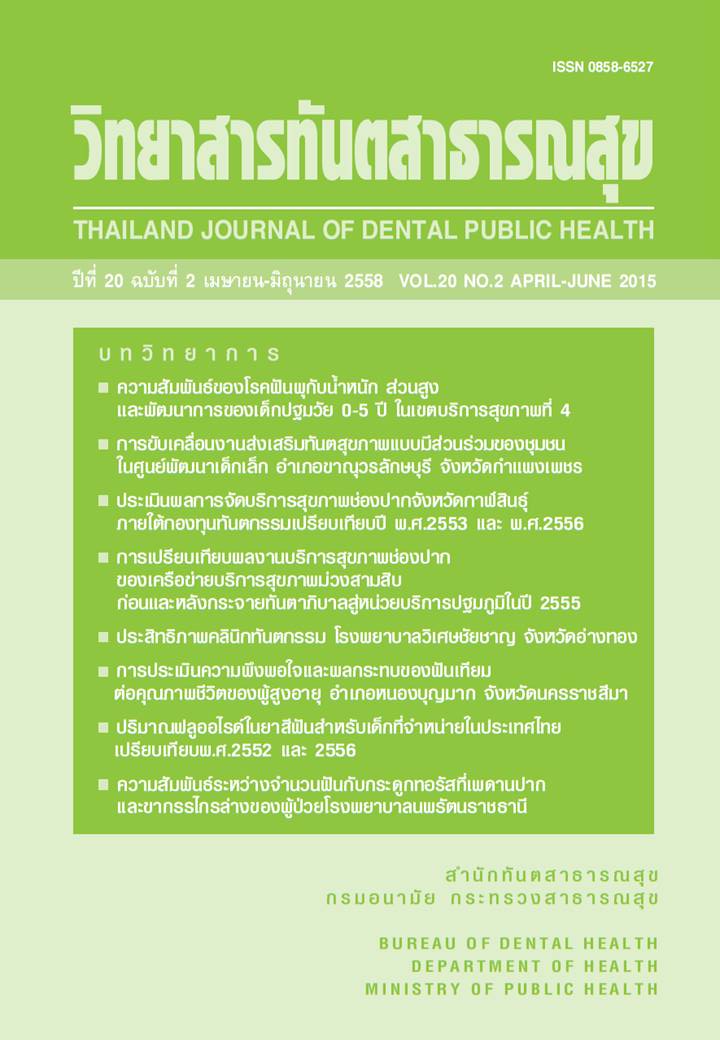Relationship between numbers of teeth and torus palatinus and torus mandibularis in the patients at Nopparat Rajathanee Hospital
Main Article Content
Abstract
The objective of this study was to investigate the relationship between numbers of teeth and the occurrence of torus palatinus (TP) and torus mandibularis (TM) in the patients at Nopparat Rajathanee Hospital. Subjects, age 13 and over, were clinically examined during February-April 2011. Numbers of the present teeth, gender and age were recorded. The subjects were divided into 6 age groups: 13-19, 20-29, 30-39, 40-49, 50-59 and 60 years and over. The differences between groups were analyzed by using Mann-Whitney U Test. Significance of the differences was set at p< 0.05. The results showed 38.5 % of subjects (851 patients) were male and 61.5 % were female. It was also found that the groups contain 46.2 % TP, 25.1 % TM and 14.5 % both tori. TP was more common in female than in male, while TM had no difference. The average number of upper teeth in total subjects, whether had TP or not, was not different in both gender. Only in males with TM had significantly more average number of lower teeth than those without TM (P = 0.0002). Average number of lower teeth was higher in total subjects with TM than those without TM (P = 0.00017). When the age was concerned, there was no different between average number of upper teeth in subjects with and without TP. However, there was a relationship between the average number of lower teeth and the occurrence of TM in 4 age groups: 20-29, 40-49, 50-59 and 60 years and over (P < 0.05).
Downloads
Article Details
References
2. Garcia A, Gonzalez J, Font R, etal. Current status of the torus palatines and torus mandibularis. Med Oral Patol Oral Cir Bucal.2010 Mar1 ; 15(2) : 353-60.
3. Seah YH. Torus palatinus and torus mandibularis: A review literature. Aust Dent J 1995;40:318-21.
4 Suzuki M, Sakai T. A familial study of torus palatines and torus mandibularis. Am J phys Anthropol 1960;18:263-272.
5. Shimahara T ,Ariyoshi Y, Nakajima Y.Mandibularar torus with tongue movement disorder : a cast report Bulletin of Osaka Medical College 53(3) 2007 osaka - med.ac.jp Available fromhttp://www.osaka-med.ac.jp/deps/b-omc/articles/533/533 shimahara.pdf.
6. Gorsky M, RavivM, Kfir E, MosKona D. Prevalence of torus palatines in a population of young and adult Israelis. Arch Oral Biol. 1996 Jun;41(6):623-5.
7. Haugen LK. Palatine and mandibular tori. A morphologic study current Norwegian population. Acta Odontol Scand 1992;50:65-67.
8. Johnson CC, Gorlin RJ, Anderson V. Torus mandibularis: a genetic study. Am J Hum Genet 1965;17:433-439.
9. Belsky JL, Hamer JS, Hubert JE, Insogna K, Johns W. Torus palatines: a new anatomical correlation with bone density in postmenopausal women. J Clin Endocrinol Metab.2003 May;88(55):2081-6.
10. Kolas S, Halperin V, Jefferis K, et al. The occurrence of Torus palatinus and torus mandibularis in 2478 dental patients. Oral Surg 1953;6:1134-41.
11. Jainkittivong A, Apinhasmit W, Swasdison S. Prevalence and clinical characteristics of oral tori in 1520 Chulalongkorn University Dental School patients. Surg Radiol Anat. 2007; 29: 125-131.
12. Sathya k, Kanneppady SK, Arishiya T. Prevalence and clinical characteristics of oral tori among outpatients in northern Malaysia. J Oral Bio Cranio. 2012 ; 2(1) : 15-19.
13. Beena.J.P. Torus palatinus in an infant : A case report. J Dent Child 2012 ; 79(3) : 181-4.
14. Sirirungrojying S, Kerdpon D. Relationship between oral tori and temporomandibular disorders. Int Dent J. 1999;49(2):101-4.
15. Hrdlicka A. Mandibular and maxillary hyperostosis. Am Anthropol 1940;27:1-67.
16. Johnson OM. Tori and masticatory stress. J Prosth Dent 1959 May ; 88(55) : 2081-6.
17. Eggen S, Natvig B. Relationship between Torus mandibularis and number of present teeth. Scand J Dent Res 1986;94:233-40.
18. Sonnier KE, Horning GM, Cohen ME. Palatal tubercles, palatal and mandibular tori: Prevalence and anatomical feature in a US population. J Periodontal 1999 Mar; 70(3):329-36.
19. Reichart PA, Neuhaus F, Sookasem M. Prevalence of torus palatinus and torus mandibularis in Germans and Thai. Community Dent Oral Epidemiol 1988;16:61-64.
20. Apinhasmit W, jainkittivong A. Concurrence of torus palatinus and torus mandibularis in a group of Thai population. J Dent Assoc Thai 2002 ; 52 : 115-9.
21. Apinhasmit W, Methatharathip D, Swasdison S, Kanwasukul S. Relationship between the occurrence of torus palatinus and torus mandibularis and numbers of teeth in a group of Thais. CU Dent J 2002 ; 25 : 203-9.
22. Kerdpon D, Sirirungrojying S. A clinical study of tori in southern Thailand: prevalence and the relation to parafunctional activity. Eur J Oral Sci 1999;107:9-13.
23. Clifford T, Lamey PJ, Fartash L. Mandibular tori, migraine and temporomandibular disorders. Br Dent J. 1996 ; 180 : 382-4


